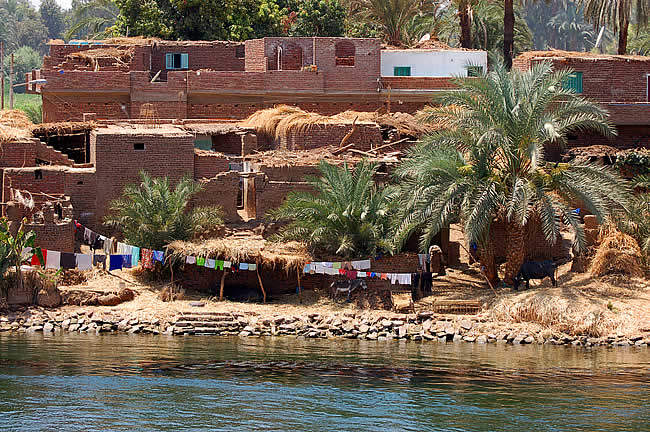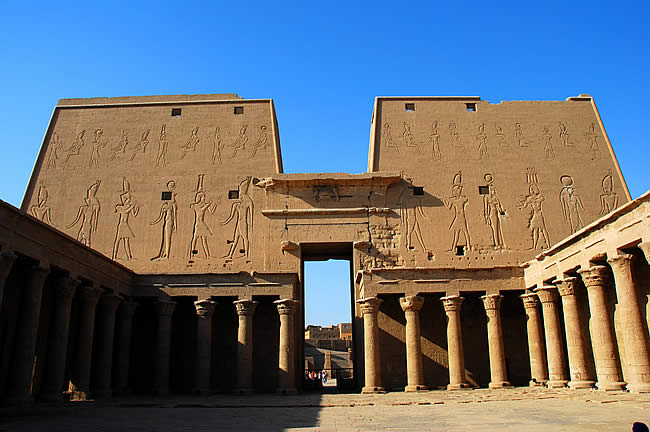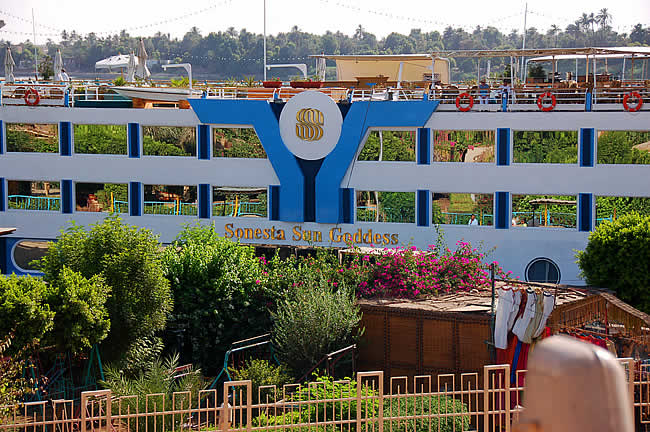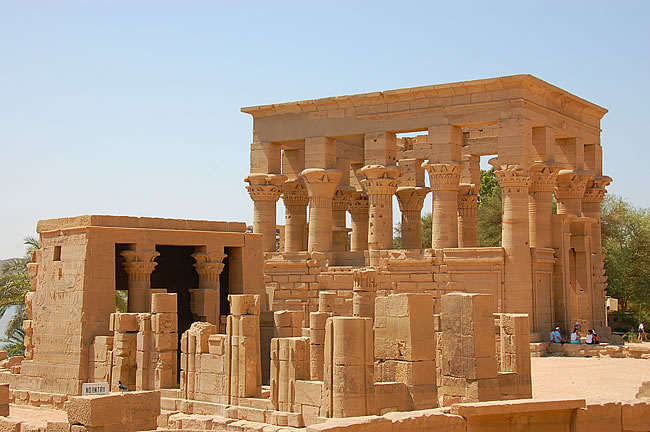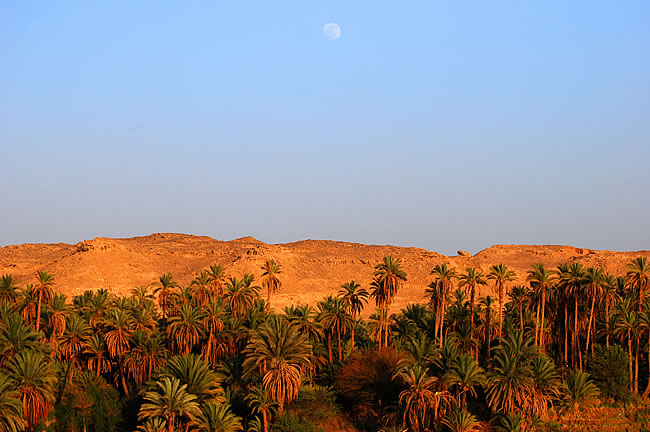Egypt Trip, Part 2: Scenes from the Nile
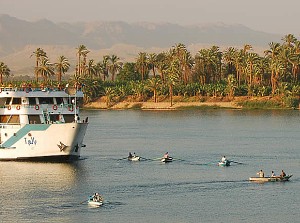
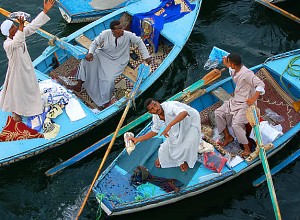
We were losing speed, drifting lazily toward a lock in the Nile that would have to be cleared before continuing upstream. Suddenly, there was activity on both sides of the wide river as men dressed in ankle-length gowns (galabeya) ran to rowboats and paddled furiously out into the channel directly ahead of us.
I walked to the front of the observation deck for a better view of the eight to ten wooden boats that had scrambled into the water to intercept us. Each carried two to four men and they were closing fast on the middle of the channel. They were perhaps 100 yards away, and our riverboat was by that time almost dead in the water.
I looked for a crew member to notify, but there were only tourists on the observation deck, each as concerned as I was about what was transpiring. I leaned over the front rail to look down on the bow of the Sonesta Sun Goddess, just outside the bridge, and saw for the first time a uniformed security officer carrying a machine gun, standing far forward and clearly visible from the water.
"Whoever they are, surely they won't try to board the boat with him here," I thought to myself.
Then we were in the middle of the chaos, boats to port and starboard sides with men standing and waving and yelling -- in various strange languages. I ran to a side rail and leaned over to look down, drawing the attention of at least three of our visitors. Each had something in his hand, and as soon as they saw me they took aim and heaved their packages at my head.
"Whoosh, whoosh, whoosh," they sailed by and plopped softly on the deck behind me. A fellow passenger picked one up to examine the contents, and to our amazement it was filled with...scarves!
These weren't pirates, or worse, they were boat-to-boat salesmen, taking "pushy" to a new level.
For the next 30 minutes, any passenger who came close enough to the rail to show so much as an eyelash to the boats four decks below was immediately targeted by bags filled with clothes -- galabeya, headdresses, scarves and more.
A few passengers opened the bags and began negotiations with the senders, who seemed capable of speaking almost any language. Some of us dutifully attempted to toss the unopened bags back down to the proper boat.
If anything could have made the experience more surreal than it already was, it was these Egyptian entrepreneurs haggling in Spanish with our Argentinian fellow passengers.
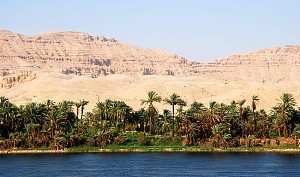
I am writing tonight from Aswan, a bustling tourist town and the upstream end of the line for Nile cruises. Our river cruise is behind us now, and this is our last night on the boat. On our voyage south from Luxor, we passed dozens of riverboats and saw the low-rise buildings of the city give way to unpopulated, palm-tree-lined banks. There were barren mountains just beyond the narrow greenbelt, a clear sign of how little of the country is fertile and how much is not.
Within a mile on either side of the Nile, there is the inhospitable desert, where nomadic Bedouin tribes manage to eke out an existence based on livestock and the perpetual search for water.
From time to time, we passed small villages, and we could see that the Nile is still the center of everyday life. Women covered from head to toe washed clothes in the river in the stifling heat, while children waded in for a swim. Long irrigation canals carried water to crops and fields with grazing water buffaloes.
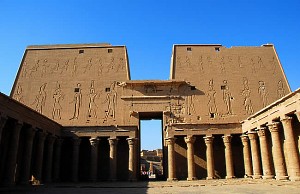
We docked in Edfu and Kom Ombo to tour well-preserved temples with Hany, our private Egyptologist.
The service and the food on the Sonesta Sun Goddess have been good, with breakfast and lunch served buffet-style and dinner ordered a la carte. There's a dessert table on the ship that would tempt anyone off their diet.
On board, we've been entertained by a belly dancer and traditional Nubian dancers, and we came appropriately attired to the galabeya party, but don't expect to see photos of our costumes in the slideshow!
Since arriving in Egypt, the high temperature each day has been north of 115. Even under the observation deck's awning, with a cool drink and the breeze kicked up from the ship's movement, it's been hot every day until sunset. Unless you are restricted by school schedules, like we are, Egypt is probably best seen from October to April.
Still, odd traveler that I am, I wouldn't want to visit the Sahara Desert in the middle of a freakish cool spell. I wanted the real thing, and got it.
Today, we visited Aswan's main tourist attraction, the High Dam. Completed in 1970 after 10 years of construction, the High Dam doubled Egypt's supply of electricity, put an end to annual flooding downstream (the original dam was in danger of failing during the floods) and greatly increased the water available for irrigation.
As the waters of the world's longest river rose behind the dam, a 310-mile-long artificial lake was created that stretches well into the country of Sudan. An estimated 90,000 inhabitants of southern Egypt and northern Sudan, from the region of Nubia, were forced to leave as their villages were flooded.
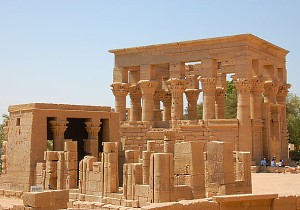
The Nubian culture is one of the oldest on Earth, dating back thousands of years. The dam was a huge step forward for the rest of the country, but the Nubians paid the price, and many now hold menial jobs here in Aswan.
We also visited one of the most beautiful of all the temples, Philae Temple, which had to be dismantled and painstakingly reconstructed on a nearby island to escape the rising water behind the dam.
We cruised through the harbor at sunset on a felucca, a traditional wooden sailing boat, and we wandered through the local bazaar after dark, where virtually every shopkeeper we passed rushed into the street to try to convince us to enter.
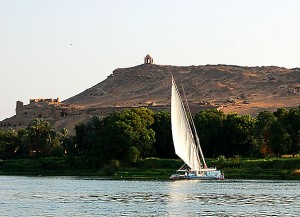
Some shops featured mounds of exotic spices, others were filled with African art or freestanding water pipes (hookahs) made of glass, metal and tubes and used to smoke fragrant tobacco or herbal fruit. As the air cooled, the bazaar filled with people and the Muslim Call to Prayer echoed down the alleys.
The hawkers were aggressive, but the sights and sounds and smells were worth it.
Tomorrow we're off to Cairo, where I'll check in from the Royal Mummy Room in the Egyptian Museum. Until then, beware the strong-armed pirates of the Nile.
For a list of all African Travel tours and safaris, click here.
For a map of Egypt and the Nile, click here.
Sincerely,
Alan Fox
Executive Chairman
Vacations To Go
Related newsletters:
Egypt Trip, Part 1: Wonders of the Nile
Egypt Trip, Part 3: A Commanding Presence




